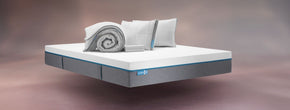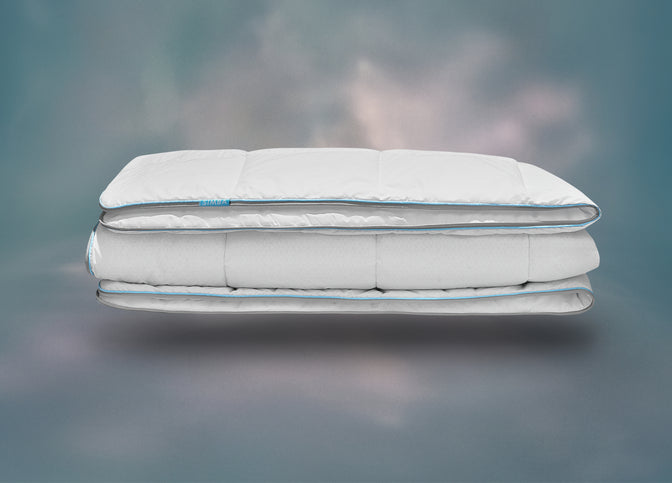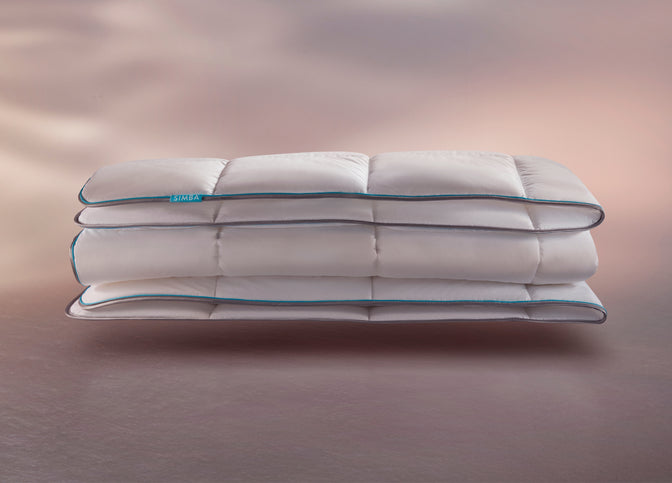What to do with old duvets

Getting rid of your old duvet? If you’re worried about it going to landfill, there are some easy, fun and mindful ways of extending its life. From repurposing to donating, this guide helps you figure out whether it’s time truly time to move on, and what to do if it is.
How long do duvets last for?
Every duvet is different, which can make determining the lifespan less straightforward than you might think. Research online, and you’ll find anywhere from 2 to 10 years recommended as the ideal length of time to use them for. This largely depends on factors like regularity of use.
Quality is also a determining factor: the higher the quality, the more years you’ll get out of it; flimsily made duvets are unlikely to stand the test of time. Coincidentally, you’ll save more money in the long run by investing in a duvet of higher quality than repeatedly buying cheaper ones. You’ll also be doing your bit for the planet by preventing more from going to landfill. A big part of a duvet’s quality comes down to materials used.
How do I know when to replace my duvet?
It’s not just recommended timescales that’ll determine when to dispose of your duvet; there are some key signs to look out for to help you figure out your ideal time to upgrade to a new one:
- It looks and feels lumpy. As duvets age, they collect sweat and dust in the same way pillows do. This can result in the filling lumping together, which not only offers uneven comfort and warmth with prevalent cold spots, but can leave you feeling far more uncomfortable than you were when you first bought it. Buying a machine washable duvet is one easy way to prevent this from happening.
- Visual wear and tear. If your duvet is displaying ripped seams and fabric, or there’s fill spilling out, this is probably your sure-fire sign it’s time to replace. This will also likely mean you’re unable to dispose of your duvet via donation. Instead, read on to see how your old duvet can be used in ways that prevent it from going to landfill.
- It’s lost its shape or feels flat. Duvet not feeling plump when you fluff or air it out? This could mean the fibres have started to break down, and you won’t be getting the usual insulating comfort you’re used to. From this point it’s unlikely to regain its shape, so a new duvet is your best bet.
- There are some persistent odours. Regular cleaning and airing out should clear your duvet of any odours from pets, overnight sweating and body care products. If however, yours is still holding onto smells or is developing a musty scent, it’s time to say goodbye.
- Your allergies are getting worse. If your duvet has boasted anti-allergy properties and is designed to help soothe reactions to dust mites or pollen, you’ll likely be experiencing a more peaceful sleep after first buying - but at the end of its life, you may notice these effects start to drop off.
- Your preferences have changed. Some of us are creatures of habit, and others like to change things up. If your preferences have changed from heavier wool duvets to lighter microfibre, you’ve developed allergies that need soothing or you simply want a softer-feel duvet, replacing might be for you.
Recycling your duvet
If you don’t have the time to repurpose your old duvet, duvet recycling might be the best option for you. Aside from local, council-run recycling centres, various home and clothing stores operate textile recycling schemes - some in-store, and some you can request packaging for and send into. If your duvet is in good condition, and you’re replacing it more out of preference than general wear and tear, you could also put up on a site like Freecycle to find it a new home.
If you’re unsure what the most suitable next step is, we suggest taking it to your nearby Household Waste Recycling Centre, who will sort through donated goods to determine whether it can be recycled, reused or disposed of responsibly.
Donating to charity
If your duvet is still in reasonably good, usable condition with minimal stains or tearing, you can donate it to a variety of charities or organisations - like animal charities and homeless shelters. Animal charities often rely on old duvets and pillows to provide warmth and comfort for pets, while homeless shelters accept more lightly used duvets to support unhoused individuals. It’s worth noting that some charity shops may also accept duvets if they’re in good condition. It’s important to note that some duvets should not be donated, like feather duvets - so do liaise directly with all these places before donating them to check whether they’ll accept it. Interested in donating? Here’s where you can…
Animal charities that take duvets
- RSPCA
- Dogs Trust
- NAWT (National Animal Welfare Trust)
- Cats Protection
Homeless shelters that take duvets
- Homeless Link
- Crisis UK
- St. Mungo’s - may accept, check directly with them to ask
- Many local branches will accept bedding, so reach out to those near you to check
Duvet disposal
If you’re unable to recycle, donate or repurpose your duvet - or you’ve exhausted every option to keep it from going to landfill - disposal might be the only route you can take. This will often be if it’s stained, torn, or has heavy odours that won’t shift. To ensure you’re disposing of it safely and properly, stuff it into a sealable bag before placing it in your general waste bin.
Investing in a new duvet
Before you think about disposing of your duvet, you’ll be needing a total upgrade. It’s an exciting process, but can sometimes be overwhelming with the seemingly infinite number of options out there. No matter which one you go for, you’ll want it to be of a high quality and last as long as possible - not just to ease the strain on your wallet, but to help you make more conscious choices that’ll positively impact the planet.
It's why we’ve designed all our duvets with every sleeper in mind, from our multi-seasonal 3-in-1 Hybrid™ Duvet, to our all-rounder Hybrid™ Duvet. All thanks to innovations like our ‘cool-touch’ Stratos® technology that helps you sleep fresher, and our super light, soft, airy fill that offers luxurious, cocooning comfort.
"Makes for a great night's sleep"- Nicola C, Hybrid™ Duvet
"Light but keeps you toasty. Comfort level 10/10!"- Lucy B, Hybrid™ 3-in-1 Duvet














